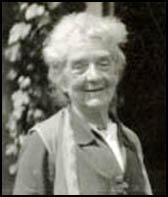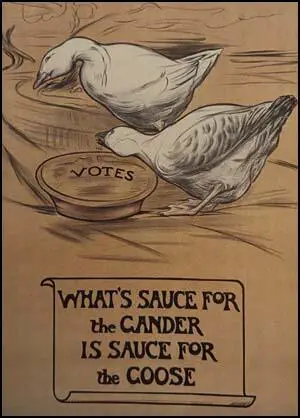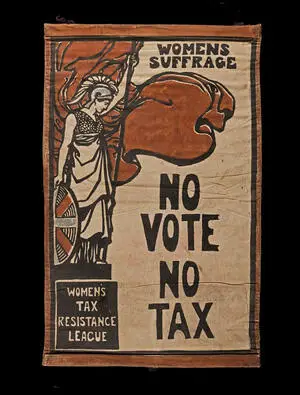Mary Sargant Florence

Emma Mary Sargant Florence, the daughter of Henry Sargant and Catherine Beale Sargant, was born in St Pancras, London, on 21 July, 1857. Her siblings included Charles Henry Sargant (1856-1942), Ethel Sargant (1863-1918) and Francis William Sargant (1870-1960). She was privately educated before attending the Slade School of Art. (1)
Mary also studied under Luc-Olivier Merson, at the Académie Colarossi in Paris. While in France she met opera singer Henry Smythe Florence. The couple married in 1888. She developed a reputation as a decorative mural painter and fresco painter. (2)
Mary and Henry moved to the USA where two children were born, Alix and Philip. In 1892 she returned to England after the death of her husband from drowning. In 1899 she built a house, Lord's Wood, at Marlow. It included a painting studio. Mary also rented a studio in Chelsea, next door to Emily Ford. (3) Walter Crane described her illustrations for The Crystal Ball (1895) as full of "power and decorative feeling" and Studio Magazine praised the "confident and virile execution" of her draughtsmanship. (4)
Mary Sargant Florence: Artist
Sargant Florence was a committed feminist. She encouraged her children to pursue their artistic talents. Alix Strachey, later became a respected psychoanalyst, and Philip Sargant Florence, a celebrated economist. In 1903 she painted her two children playing chess: "Sargant Florence’s children are the subject of this painting. Philip (aged thirteen) and Alix (nine) are shown engrossed in their game. The interlocking composition excludes the viewer and there is little sentimentality. The flat treatment of the painted surface, heightened by the matt finish of egg tempera, focuses attention on the bold pattern of line and contrasted colours." (5)

In 1905 Mary Sargant Florence joined the Central Society for Women's Suffrage. In December 1906, she was present at a banquet organised by Millicent Garrett Fawcett. Over the next few years she donated money to the National Union of Suffrage Societies, Women Social & Political Union and Women's Freedom League. She also attended meetings of the Tunbridge Wells Suffrage Society. Annie Kenney and Teresa Billington-Greig enjoyed weekend rests with her at her Marlow home. (6)
Artist Suffrage League
The Artists' Suffrage League was founded in January 1907 by professional women artists to help with the preparations for the first large-scale public demonstration by the National Union of Suffrage Societies. Its object was "to further the cause of Women's Enfranchisement by the work and professional help of artists... by bringing in an attractive manner before the public eye the long-continued demand for the vote." (7)
The first chairperson of the Artists' Suffrage League was Mary Lowndes, an important stained-glass and poster artist. She designed many of the banners used by the NUWSS including those for the demonstration of 21 June 1908, and for the Women's Pageant of Trades and Professions held the following year at the Albert Hall as part of the International Woman Suffrage Alliance Congress. (8)

Mary Sargant Florence joined the Artists' Suffrage League and in 1908 produced the poster, "What's Source for the Gander is Sauce for the Goose". It was so popular it was reprinted in 1910. She also designed a "Dare to be Free" banner for the Women's Freedom League. (9)
Women's Tax Resistance League
On 22nd October 1909 when the Women's Freedom League (WFL) established the Women's Tax Resistance League (WTRL). (10) Mary Sargant Florence was a founder member and was on its committee. (11) The motto adopted by the WTRL was "No Vote No Tax". According to Elizabeth Crawford, the author of The Women's Suffrage Movement: A Reference Guide 1866-1928 (2000): "When bailiffs seized goods belonging to women in lieu of tax, the TRL made the ensuing sale the occasion for a public or open-air meeting in order to spread the principles of women's suffrage and to rouse public opinion to the injustice of non-representation meted out on tax-paying women." (12)
Mary Sargant Florence designed a badge for the WTRL, showing a ship under sail and the slogan, "No Vote, No Tax". She also designed a poster depicting a Britannia figure, holding a a flowing "Reform" banner, and was used as a blank advertising poster, to be filled in with details of a society's meetings. The same design was also used for postcards. A painted banner was created by the Suffrage Atelier and used in the 18th June 1910 WSPU procession. (13)

Over the next few years over 220 women took part in this campaign. This included Janie Allan, Charlotte Despard, Beatrice Harraden, Teresa Billington-Greig, Edith How-Martyn, Cicely Hamilton, Dora Marsden, Helena Normanton, Anne Cobden Sanderson, Emma Sproson, Louisa Garrett Anderson, Sime Seruya, Margaret Nevinson, Henria Williams, Violet Tillard, Edith Zangwill, Maud Arncliffe Sennett, Lena Ashwell, Minnie Turner, Margory Lees, Dora Montefiore, Evelyn Sharp, Eveline Haverfield, Sophia Duleep Singh and Clemence Housman. Mary Sargant Florence was twice prosecuted for refusing to pay her taxes. (14)
In April 1914, Mary Lowndes, wrote in The Common Cause about the best artists working in England. "Among the painters of large decorative designs who exhibit in England, Mary Sargant Florence surely stands in the first rank with her strange, bold, original figures, and admirable effects of calculated perspectives." (15)
First World War
Most members of the Women's Freedom League, were pacifists, and so when the First World War was declared in 1914 they refused to become involved in the British Army's recruitment campaign. The WFL also disagreed with the decision of the NUWSS and WSPU to call off the women's suffrage campaign while the war was on. Mary Sargant Florence believed that the British government did not do enough to bring an end to the war and became a member of the British general committee for the Women's International Congress. (16)
Mary Sargant Florence joined forces with Charles Kay Ogden to produce the anti-war pamphlet, Militarism verses Feminism ( (1915). The authors wrote: "For Feminism history has only one message on the question of war, and it is this: Militarism has been the curse of women, as women, from the first dawn of social life. Owing to the turmoil in which it has kept every tribe and every nation almost without exception, mankind has seldom been able to pause for a moment to set social affairs in order - and the first and most crying reform has ever been the condition of woman. Violence at home, violence abroad; violence between individuals, between classes, between nations, between religions; violence between man and woman: this it is which, more than all other influences, has prevented the voice of woman being heard in public affairs until almost yesterday.... War, and the consequent enslavement of women, has been the main inducement to Polygamy, with its conception of women as property, and its debasement of love to physical enjoyment: War has engendered and perpetuated that dominance of man as a military animal which has pervaded every social institution from Parliament downwards. In War man alone rules: when War is over man does not surrender his privileges. Militarist ethics have perverted the peaceful and individualising tendencies of Industry to which woman owes so much." (17)
Later Work
In 1919 Mary Sargant Florence taught Stanley Spencer fresco painting in preparation for the Burghclere Chapel murals. (18) Spencer's series of seventeen paintings was inspired by his own experiences during the First World War, in which he served as an orderly with the Royal Army Medical Corps. He began the work in 1923 and the series was completed in 1932. It is dominated by the Resurrection scene behind the altar, in which dozens of British soldiers lay the white wooden crosses that marked their graves at the feet of a distant Christ. The series chronicles Spencer's everyday experiences of the war rather than any scenes of action. (19)
Mary Sargant Florence exhibited at the Royal Academy and the New English Art Club. She edited the Papers of the Society of Painters in Tempera: 1901-1907 (1928) and published Colour Coordination (1940). (20) According to the Birmingham Daily Post, "Mary Sargant Florence... carried out several schemes of decoration, notably at the Old School, Oakham, Rutland, and at Bournville Day Continuation Schools, Birmingham and she also designed a tapestry portiere made by the Stratford-upon-Avon School of Weaving. (21)
Mary Sargant Florence died on 14th December, 1954. She left £38,738 in her will and left some paintings to Dora Meeson Coates.
Primary Sources
(1) Mary Lowndes, The Common Cause (17th April 1914)
It is commonplace of observation that the artist needs freedom for his development, and instructively adopts a life untrammelled by convention. Women are not free – they have never been free. When the winds of a new inspiration swept across European countries, or blew from Olympia through Greece, or stirred to high ideals the Taoists of China, they shook indeed the purdah curtain of humanity, behind which from age to age, woman everywhere has performed her menial tasks, or taken her dull ease, but they did not blow them wide. If the age of woman has dawned – and it has dawned – it is not to take a stand beside the great creative artists of the world that the prisoners of freedom cast aside their chains and step forth at last from their long seclusion – it is to lend a world-wide revolt against the prejudice and ancient tyranny that, in the teeth of nature and development, struggle ever to keep women the inferior creature they proclaim her….
Among the painters of large decorative designs who exhibit in England, Mary Sargant Florence surely stands in the first rank with her strange, bold, original figures, and admirable effects of calculated perspectives.
(2) Mary Sargant Florence and Charles Kay Ogden, Militarism verseus Feminism (1915)
It is hard indeed, at a time like the present, to detach oneself even for a moment from the duties which the common danger has imposed on us all–men and women in every country. But, sooner or later, our attitude to certain fundamental questions must be decided, lest the critical moment come upon us unprepared. Every movement that stands for progress raises such questions, and none is more important than the future of the women's movement in relation to war and militarism. Will–or should–its course be modified in the light of recent events? It is hardly too early to discuss this question, for the advocates of militarism are already busy in our midst, and it is easy to take a wrong turning or a short view. Opinions within the movement are divided. Yet it seems probable that there would be less disagreement if once the results of militarism were clearly understood.
We are faced by issues on which it seems not improbable that the ideals of most men are different from those of most women.. The difference has usually been obscured in feminist propaganda: the argument so often has to run, and quite truly, that on the majority of questions there will be no great split of society into two halves, the men wanting one thing and the women another. But militarism, as such, raises different problems.
For Feminism history has only one message on the question of war, and it is this: Militarism has been the curse of women, as women, from the first dawn of social life. Owing to the turmoil in which it has kept every tribe and every nation almost without exception, mankind has seldom been able to pause for a moment to set social affairs in order - and the first and most crying reform has ever been the condition of woman. Violence at home, violence abroad; violence between individuals, between classes, between nations, between religions; violence between man and woman: this it is which, more than all other influences, has prevented the voice of woman being heard in public affairs until almost yesterday. War has created Slavery with its degrading results for women, and its double standard of morality from which we are not yet completely free: War, and the consequent enslavement of women, has been the main inducement to Polygamy, with its conception of women as property, and its debasement of love to physical enjoyment: War has engendered and perpetuated that dominance of man as a military animal which has pervaded every social institution from Parliament downwards. In War man alone rules: when War is over man does not surrender his privileges. Militarist ethics have perverted the peaceful and individualising tendencies of Industry to which woman owes so much. Industry has united with competition to produce Industrial Warfare: Commerce has combined with Imperialism for the capture of markets and the exploitation of the lower races. Militarism has ruined Education with its traditions of discipline and its conception of history. Militarism has even left its blighting imprint on Religion - on Mohammedanism the religion of conquest with its depreciation of woman; on the religion of the Prince of Peace, so that the Churches can say what they are not ashamed to say to-day. War, and the fear of War, has kept woman in perpetual subjection, making it her chief duty to exhaust all her faculties in the ceaseless production of children that nations might have the warriors needed for aggression or defence. She must not have any real education - for the warrior alone required knowledge and independence; she must not have a voice in the affairs of the nation, for War and preparation for War were so fundamental in the life of nations that woman, with her silly humanitarianism, must not be allowed to meddle therewith! And so War, which the influence of women alone might have prevented, was used as the main argument against enfranchisement, as it had been the main barrier to emancipation in the past. The circle is complete.
War, Militarism, Imperialism; in every form they have proved her undoing, and yet women hesitate to-day on which side to throw their influence! Over and over again the greatest statesmen have said that peace was Utopian only because public opinion was not ready for it; and no one has said it more emphatically than Sir Edward Grey. But who is to create the new public opinion? Have women no better answer than hatred or despair? Over and over again Suffragists have seen that it was from militarists that their ideals met with the most bitter opposition. They have never been tired of pointing to the baleful influence on our social life of ex-Viceroys and of men accustomed to the military despotism of the East. Is it purely by chance that it is the countries which, by position or circumstances, have been most free from military domination and constant preparation for war that have felt able to listen to the demands of women? The United States, New Zealand, Norway, Finland, Iceland, and the rest–they are countries in which war plays but a small part. The conscriptionist countries, on the other hand, have always looked askance at women's claims, and who has not heard German women complain "It's all very well for you to talk, but you don't know what it means to live in a country where everything is secondary to the training of the warrior male"? On February 5th, Mr. Cloudesley Brereton wrote in The Common Cause, "Germany stands forth as the chief exponent of the patriarchal conception." But, and let us not be led astray, only as the chief exponent; and from her faults let us learn. All Europe, as we show in Chapter III, is constantly menaced by similar tendencies....
It is hard to write without danger of misrepresentation, and it is especially important to make it clear that nothing is here implied as regards individuals. As far as our argument goes the majority of men who compose the armies of Europe at the present moment might be ardent supporters of women's rights! The indictment is against militarism. Since the war broke out every woman's paper has been full of complaints as to the way in which women have been treated - quite apart from atrocities and sufferings, and the break down of the theory that women are 'protected,' so admirably exposed in The Englishwoman, January 1915.
References
(1) Elizabeth Crawford, Art and Suffrage: A Biographical Dictionary of Suffrage Artists (2018) page 93
(2) Lisa Tickner, The Spectacle of Women: Imagery of the Suffrage Campaign (1987) page 244
(3) Elizabeth Crawford, Art and Suffrage: A Biographical Dictionary of Suffrage Artists (2018) page 93
(4) Lisa Tickner, The Spectacle of Women: Imagery of the Suffrage Campaign (1987) page 245
(5) The Tate Gallery (October 2020)
(6) Elizabeth Crawford, Art and Suffrage: A Biographical Dictionary of Suffrage Artists (2018) page 95
(7) The Suffrage Annual and Women's Whose Who (1913) page 12
(8) Nancy Armstrong, Mary Lownes : Oxford Dictionary of National Biography (23rd September, 2004)
(9) Elizabeth Crawford, Art and Suffrage: A Biographical Dictionary of Suffrage Artists (2018) page 94
(10) Teresa Billington Greig, The Non-Violent Militant: Selected Writings of Teresa Billington-Greig (1987) page 104
(11) Lisa Tickner, The Spectacle of Women: Imagery of the Suffrage Campaign (1987) page 245
(12) Elizabeth Crawford, The Women's Suffrage Movement: A Reference Guide 1866-1928 (2000) page 672
(13) Elizabeth Crawford, Art and Suffrage: A Biographical Dictionary of Suffrage Artists (2018) page 94
(14) Lisa Tickner, The Spectacle of Women: Imagery of the Suffrage Campaign (1987) page 244
(15) Mary Lowndes, The Common Cause (17th April 1914)
(16) Elizabeth Crawford, Art and Suffrage: A Biographical Dictionary of Suffrage Artists (2018) page 94
(17) Mary Sargant Florence and Charles Kay Ogden, Militarism verseus Feminism (1915)
(18) Lisa Tickner, The Spectacle of Women: Imagery of the Suffrage Campaign (1987) page 244
(19) David Boyd Haycock, A Crisis of Brilliance: Five Young British Artists and the Great War (2009) page 331
(20) Elizabeth Crawford, Art and Suffrage: A Biographical Dictionary of Suffrage Artists (2018) page 94
(21) Birmingham Daily Post (17th December 1954)

